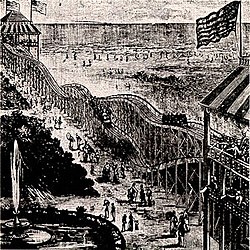The oldest roller coasters are believed to have originated from the so-called "Russian Mountains", which were specially constructed hills of ice, located especially around Saint Petersburg. Built in the 17th century, the slides were built to a height of between 21 and 24 m (70 and 80 feet), consisted of a 50 degree drop, and were reinforced by wooden supports.
Some historians say the first roller coaster - thrill rides was built under the orders of Russia's Catherine the Great in the Gardens of Oranienbaum in Saint Petersburg in the year 1784. Other historians believe that the first modern roller coaster was built by the French. The Promenades Aeriennes in Parc Baujon and the Les Montagnes Russes à Belleville (The Russian Mountains of Belleville) were both constructed in Paris in 1817 and both featured wheeled cars securely locked to the track, guide rails to keep them on course, and higher speeds.
The name Russian Mountains to designate a roller coaster ride is preserved in most Latin languages. However, the Russian term for roller coasters is "американские горки" ("amerikanskiye gorki"), which means "American Mountains".

Scenic gravity railroads
Thompson's Switchback Railway, 1884.
In 1827, a mining company in Summit Hill, Pennsylvania constructed the Mauch Chunk gravity railroad, an 8.7-mile (14.0 km) downhill track used to deliver coal to Mauch Chunk (now known as Jim Thorpe), Pennsylvania. By the 1850s, the "Gravity Road" (as it became known) was providing rides to thrill-seekers for 50 cents a ride. Railway companies used similar tracks to provide amusement on days when ridership was low.
Using this idea as a basis, LaMarcus Adna Thompson began work on a gravity Switchback Railway that opened at Coney Island in Brooklyn, New York in 1884. Passengers climbed to the top of a platform and rode a bench-like car down the 600-foot (180 m) track up to the top of another tower where the vehicle was switched to a return track and the passengers took the return trip.This track design was soon replaced with an oval complete circuit. In 1885, Phillip Hinkle introduced the first full-circuit coaster with a lift hill, the Gravity Pleasure Road, which was soon the most popular attraction at Coney Island. Not to be outdone, in 1886 LaMarcus Adna Thompson patented his design of roller coaster that included dark tunnels with painted scenery. "Scenic Railways" were to be found in amusement parks across the county, with Frederick Ingersoll's construction company building many of them in the first two decades of the 20th century.
Popularity, decline and revival
By 1919, the first underfriction roller coaster funfair rides had been developed by John Miller. Soon, roller coasters spread to amusement parks all around the world. Perhaps the best known historical roller coaster, The Cyclone, was opened at Coney Island in 1927.
The Great Depression marked the end of the first golden age of roller coasters, and amusement parks in general went into decline. This lasted until 1972, when The Racer was built at Kings Island in Mason, Ohio (near Cincinnati). Designed by John Allen, the instant success of The Racer began a second golden age, which has continued to this day.
Steel roller coasters
In 1959 Disneyland introduced a new design breakthrough with Matterhorn Bobsleds. This was the first roller coaster to use a tubular steel track. Unlike wooden coaster rails, which are generally formed using steel strips mounted on laminated wood, tubular steel can be easily bent in any direction, which allows designers to incorporate loops, corkscrews, and many other maneuvers into their designs. Most modern roller coasters are made of steel, although wooden coasters are still being built.
In 1959 Disneyland introduced a new design breakthrough with Matterhorn Bobsleds. This was the first roller coaster to use a tubular steel track. Unlike wooden coaster rails, which are generally formed using steel strips mounted on laminated wood, tubular steel can be easily bent in any direction, which allows designers to incorporate loops, corkscrews, and many other maneuvers into their designs. Most modern roller coasters are made of steel, although wooden coasters are still being built.

没有评论:
发表评论